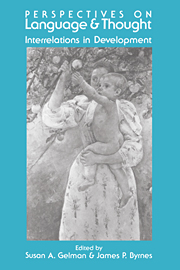Book contents
- Frontmatter
- Contents
- Preface
- List of contributors
- I INTRODUCTION
- II RELATIONS BETWEEN WORD LEARNING AND CATEGORIZATION
- 2 Acquisitional principles in lexical development
- 3 The whole-object, taxonomic, and mutual exclusivity assumptions as initial constraints on word meanings
- 4 Convergences between semantic and conceptual organization in the preschool years
- 5 Language and categorization: The acquisition of natural kind terms
- 6 Theories, concepts, and the acquisition of word meaning
- III LOGICAL, CAUSAL, AND TEMPORAL EXPRESSIONS
- IV THE ROLE OF SOCIAL INTERACTION
- Author index
- Subject index
2 - Acquisitional principles in lexical development
Published online by Cambridge University Press: 05 January 2012
- Frontmatter
- Contents
- Preface
- List of contributors
- I INTRODUCTION
- II RELATIONS BETWEEN WORD LEARNING AND CATEGORIZATION
- 2 Acquisitional principles in lexical development
- 3 The whole-object, taxonomic, and mutual exclusivity assumptions as initial constraints on word meanings
- 4 Convergences between semantic and conceptual organization in the preschool years
- 5 Language and categorization: The acquisition of natural kind terms
- 6 Theories, concepts, and the acquisition of word meaning
- III LOGICAL, CAUSAL, AND TEMPORAL EXPRESSIONS
- IV THE ROLE OF SOCIAL INTERACTION
- Author index
- Subject index
Summary
Languages depend for their content on words, and learning words makes up a large proportion of what children do as they acquire language. By one calculation, children learn on average nine new words a day between age 1 and age 6. And beyond age 6, by other estimates, they continue to add some six words a day to their vocabulary (see Carey, 1978; Liberman, 1989; Templin, 1957). But learning a word – its form and meaning – is no small task. It requires that one be able to identify the form of the word, its beginning and end, so that it can be picked out from the stream of speech and produced, eventually, in a form recognizable to others. And it requires that one learn what it means. This includes learning what parts of words mean, since knowing this offers children a way of expanding their current vocabulary much as adults do. When the occasion demands, children can construct new words out of known parts that they combine to convey novel meanings. They can also analyze known parts as they try to interpret new words.
But an unfamiliar word heard on a particular occasion could pick out an event or an object, a state or a relation, or a part of any of these. How does one narrow down the possibilities on each occasion in order to arrive at the conventional meaning? Children are aided in this task, I propose, by their reliance on various principles that help guide their acquisition of words. Two of these principles are general pragmatic principles that guide language use for adults as well as children.
- Type
- Chapter
- Information
- Perspectives on Language and ThoughtInterrelations in Development, pp. 31 - 71Publisher: Cambridge University PressPrint publication year: 1991
- 17
- Cited by

